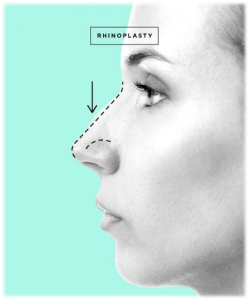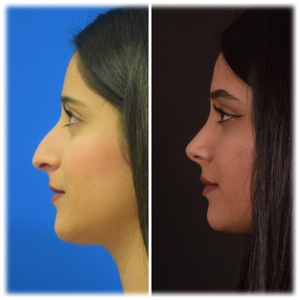It is one of the most applied aesthetic operations in the world and usually called as ‘‘nose job’’.
REACH GOLDEN RATIO WITH THE MIRACLES OF RHINOPLASTY!
Rhinoplasty is one of the most applied aesthetic operations in the world usually called as ’’nose job’’. Rhinoplasty is important because the nose is the most prominent organ in the facial area. For this reason, it is an essential and experience-based procedure.
Rhinoplasty involves modifying both the bones (upper part) and the cartilage (lower part) of the nose for a variety of desired aesthetic results: a narrower nose, a higher bridge, a more refined tip, removal of a bump, and so on.
PROCESS
First is commonly called the “closed rhinoplasty” or ‘’endonasal approach’’. During a closed rhinoplasty procedure, the incisions are hidden inside part of the patient’s nose. It involves modifications performed inside of the nostrils. A closed rhinoplasty is generally recommended for patients who require nasal bridge modifications.
The other is called the “open rhinoplasty” or ‘’external approach’’. It is used to treat the nasal tip and middle portion of the nose. It involves the use of a small bridging incision to link incisions to the right and left nostrils. The bridging incision allows the nasal skin to be folded upward, thereby providing full access to the lower nasal skeleton.

How is it performed?
Rhinoplasty operation should be done in a hospital and is a type of operation performed mostly under general anesthesia. In simple rhinoplasty operations that require only small touches, local anesthesia can be applied according to the surgeon’s preference. (You’ll receive local anesthesia to your nose, which will also numb your face. You may also get medication through an IV line that makes you groggy, but you’ll still be awake).
Once you’re numb or unconscious, your surgeon will make cuts between or inside your nostrils. They’ll separate your skin from your cartilage or bone and then start the reshaping. If your new nose needs a small amount of additional cartilage, your doctor may remove some from your ear or deep inside your nose. If more is needed, you might get an implant or a bone graft. A bone graft is additional bone that’s added to the bone in your nose.
The operation lasts between 2-2.5 hours by our professional surgeons but if the surgery is complex, it can take longer. Rhinoplasty takes 1 day with preoperative preparations and post-operative applications and observation time.
Are you a good candidate for this type of surgery?

If you have a rational insight about the deformity of your nose or have reasonable expectations about your appearance; you are a good candidate. To qualify for open or closed rhinoplasty surgery an individual’s nasal anatomy must be fully developed. The ideal age for surgery varies based on the
patients.
How long is the healing period?
The healing time of the patients who have undergone nasal aesthetics varies according to the size of the operation, the patients can usually get up and walk around within 4 – 6 hours, and if there is no nausea and vomiting after 6 hours, they may start to eat. Patients are discharged on the same day in some cases, and sometimes discharged the next day after observation for 1 night. Post-operatively, patients may return to work the next day and turn back to their daily life completely within a period of 1 week to 10 days if no complications occur. Post-operative swelling and bruises are normal and diminish in a week. One month after the operation, 75-80% of the edema diminishes. The targeted shape and full recovery are achieved six month-one year after surgery.
Advices after the operation;
- Post-operative pain usually occurs and therefore, pain relief is applied to the patient without waiting for the effect of anesthesia to pass. Afterwards, medicines recommended by your doctor should be used without interruption.
- It is not recommended to stand up for a period of 4-6 hours after surgery. The first time you stand up, it is normal to experience dizziness and darkness.
- Blood leakage from the nasal area is normal both during and after surgery. This bleeding can be swallowed unintentionally, causing nausea and vomiting. If there is no nausea 6 hours after the operation, water can be drunk gradually and then the patient is able to turn back their normal eating habits by staying away from hot and greasy products.
- Directly after the surgery cold press with ice cubes must be applied to the operated area for a day in order to prevent pain and possible bruises.
- It is normal for swelling and bruises to form under the eyes, around the nose and in certain parts of the face and will gradually diminish. In order to prevent bleeding, the pillow should be kept high and no water should be drawn into the nose for the first 15 days.
- It is normal for the nose to remain blocked during this process. It is not recommended to wear glasses or sunglasses at least 3 months to achieve the exact shape.
